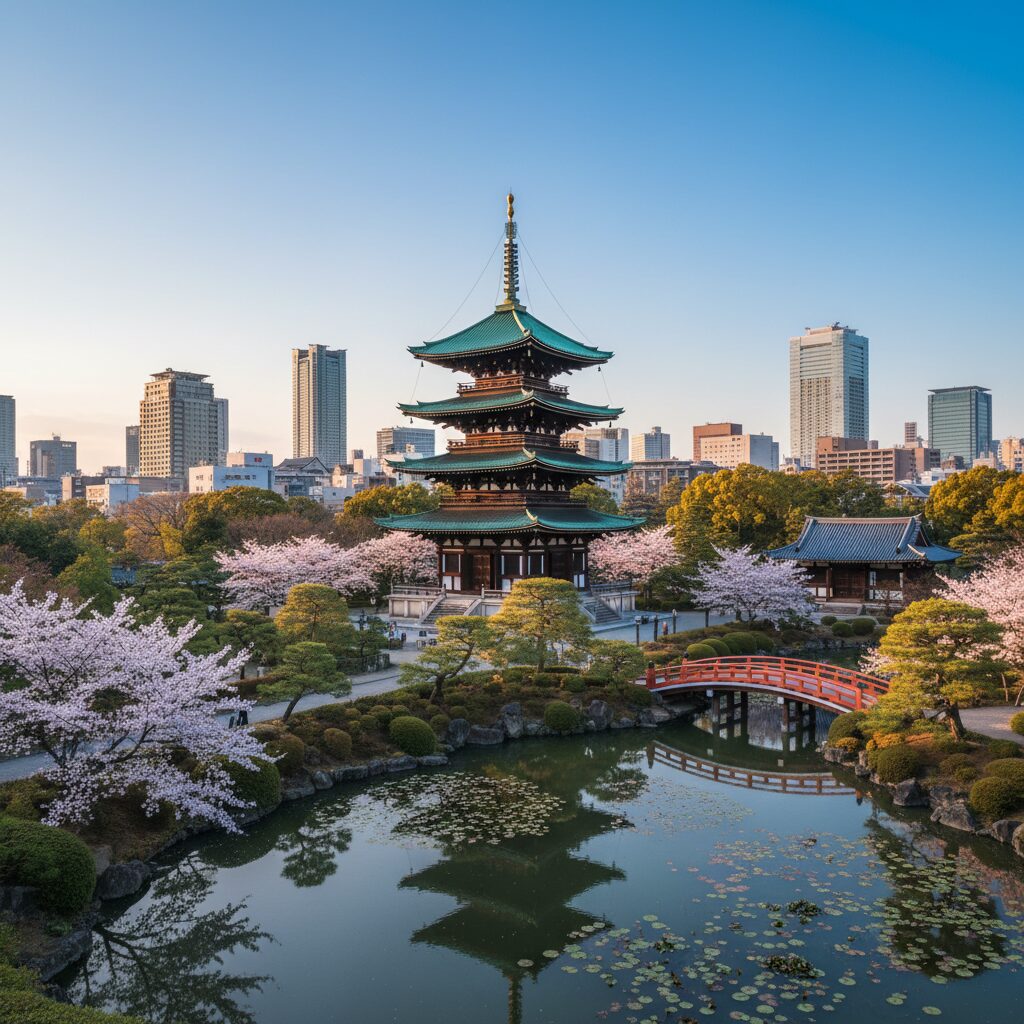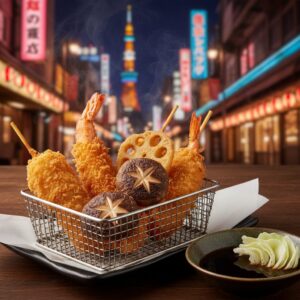In the sprawling, energetic metropolis of Osaka, a city that pulses with an insatiable appetite for the new, there exists a district that serves as its very soul. This is Tennoji, a captivating neighborhood where the whispers of ancient history resonate against the sleek glass of modern ambition. It is a place where you can begin your day in the serene courtyards of Japan’s oldest Buddhist temple and end it by gazing upon a glittering urban sea from the observation deck of its tallest skyscraper. Tennoji is not merely a collection of landmarks; it is a living, breathing timeline of Osaka itself, a vibrant tapestry woven from threads of spirituality, nature, commerce, and pure, unadulterated fun. Here, the sacred and the secular don’t just coexist—they dance together, creating a rhythm that is uniquely Osakan. Whether you seek quiet contemplation, family-friendly adventure, a taste of retro Japan, or the height of contemporary luxury, Tennoji welcomes you with open arms, ready to reveal the multifaceted heart of this incredible city. It is a journey through centuries, all conveniently located within a few captivating city blocks, offering a profound glimpse into the past, present, and future of Japan’s Kitchen.
To truly taste the essence of this incredible city, be sure to explore the vibrant Tsuruhashi Market, a labyrinth of flavor where Osaka’s soul comes alive.
The Spiritual Heart: Shitennoji Temple
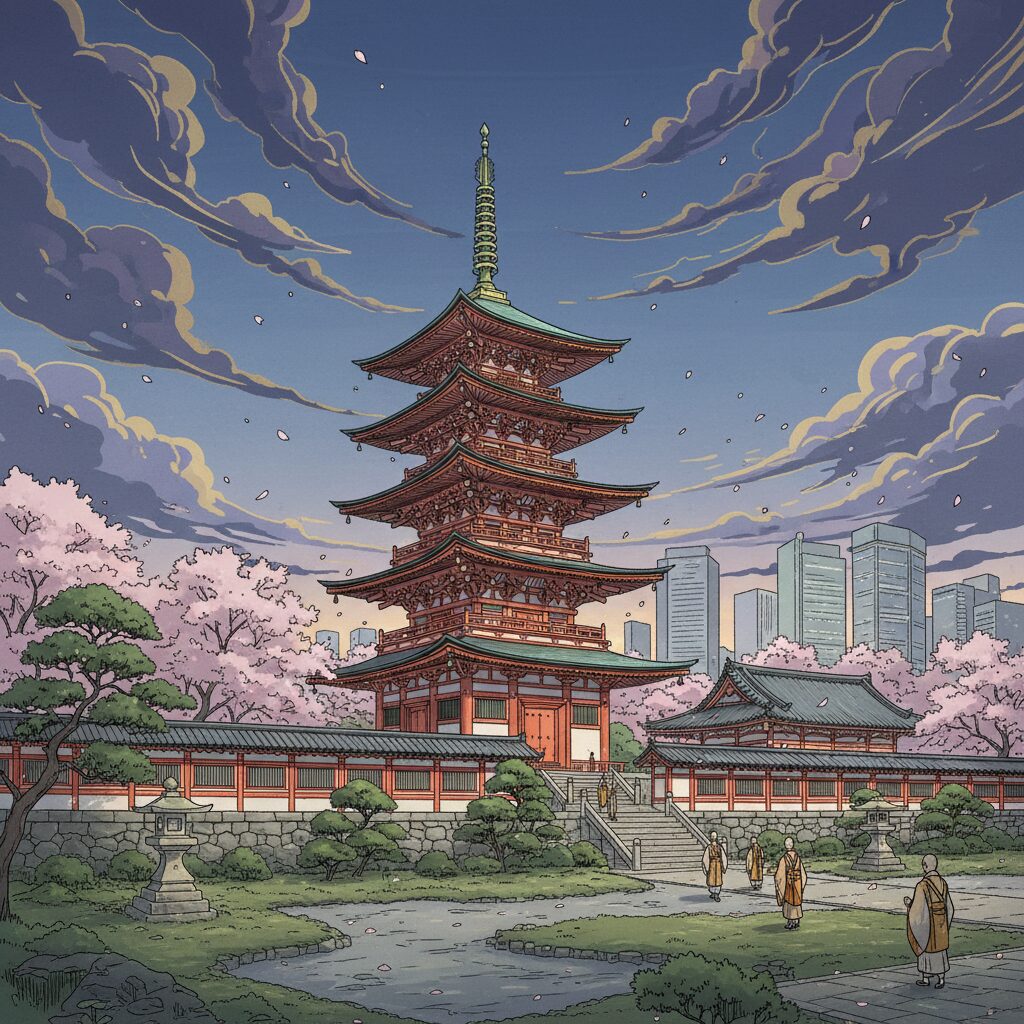
Long before Osaka became a dazzling cityscape of neon lights and commerce, it served as a gateway for new ideas and beliefs flowing into Japan from the Asian continent. Among these, Buddhism was the most profound, and its first great advocate, Prince Shotoku, chose this very site in Tennoji to establish its spiritual foundation. Founded in 593 AD, Shitennoji is celebrated as one of Japan’s oldest officially managed Buddhist temples, a monument not only to faith but also to the very formation of the Japanese state. Passing through its grand southern gate, the Nandaimon, is like leaving behind the relentless pace of the 21st century. The air becomes still, carrying the faint, sweet scent of burning incense and the soft crunch of gravel beneath your feet. The roar of city traffic fades away, replaced by the gentle cooing of doves and the rhythmic chanting that occasionally drifts from the main halls. More than a tourist destination, it remains an active place of worship, a site of immense cultural significance that has provided solace and inspiration for over fourteen centuries. Though its buildings have been repeatedly destroyed by fire and war throughout its long history, they have always been carefully rebuilt to mirror the original 6th-century design—a powerful testament to the city’s enduring resilience and profound respect for its origins.
The Sacred Precincts: Exploring the Temple Grounds
The inner precinct, known as the garan, is arranged with perfect symmetry and spiritual symbolism, featuring a style unique to this temple called Shitennoji-gata garan haichi. The main buildings align perfectly along a north-south axis, creating a strong sense of order and harmony. Walking along this central path symbolizes a spiritual journey.
The Five-Storied Pagoda (Goju-no-to)
Towering over the temple grounds is the magnificent Five-Storied Pagoda. Its elegant, gently sweeping eaves reach skyward, serving as a beacon of faith visible throughout the surrounding neighborhood. Each of its five stories represents one of the five elements of Buddhist cosmology: earth, water, fire, wind, and void. What sets Shitennoji’s pagoda apart is that visitors are allowed to ascend its inner staircase, unlike most pagodas in Japan. As you climb the steep wooden stairs, passing vibrant murals and enshrined relics on every level, you feel a tangible connection to the generations of devotees who have made this same ascent. The view from the top floor, overlooking temple rooftops and the modern city beyond, is a poignant reminder of the passage of time and the temple’s enduring presence within it.
The Main Hall (Kondo) and Lecture Hall (Kodo)
Continuing north from the pagoda leads you to the Kondo, or Golden Hall—the temple’s spiritual heart, where the principal objects of worship reside. Inside, the atmosphere is one of deep reverence. Flickering candlelight illuminates golden statues and intricate carvings, while the air is thick with the scent of aged wood and incense. Here, Prince Shotoku is honored alongside the Four Heavenly Kings, the Shitenno, who lend the temple its name and serve as divine guardians. Further north lies the Kodo, or Lecture Hall, a grand space where monks once gathered to study sacred sutras. Today, it houses priceless Buddhist statues and paintings, serving as a treasury of artistic and spiritual heritage. The serene expressions on these ancient figures seem to impart timeless wisdom, inviting quiet contemplation.
A Glimpse of Paradise: The Gokuraku-jodo Garden
Beyond the main temple precinct is a hidden treasure, the Gokuraku-jodo Garden. The name means “Paradise Pure Land Garden,” designed as a physical representation of the Western Paradise described in the Amida sutras. At its center lies a tranquil pond filled with lotus flowers and turtles, surrounded by meticulously landscaped paths, stone lanterns, and carefully arranged rocks. Walking the path offers a meditative experience, with each turn revealing a beautifully composed scene. The garden’s beauty changes dramatically with the seasons. In spring, soft pink and white cherry and plum blossoms create a riot of color. Summer brings lush green foliage and blooming sacred lotus flowers. Autumn sets the maple trees ablaze in fiery red and gold hues, their reflections shimmering on the pond’s surface. Visiting this garden feels like stepping into another world—a peaceful, idealized realm that offers a true escape and a moment of pure serenity.
Practical Notes for Visitors
To enjoy Shitennoji at its most peaceful, visit early in the morning soon after it opens. While access to the outer grounds is free, a modest fee is required to enter the central precinct and the Gokuraku-jodo Garden. A special time to visit is on the 21st and 22nd of each month, when a vibrant flea market takes over the temple grounds. Hundreds of vendors sell everything from antiques and pottery to street food and secondhand kimonos. This lively event showcases the temple as a genuine community hub.
A Green Oasis in the Concrete Jungle: Tennoji Park and Tenshiba
Directly beside the ancient spiritual grounds of Shitennoji lies a completely different type of sanctuary: Tennoji Park. This vast green space has long functioned as a recreational haven for the city, but in recent years, its main entrance area has been spectacularly transformed into a lively destination known as Tenshiba. The name itself is a simple blend of “Tennoji” and “shibafu,” the Japanese word for lawn, perfectly reflecting the area’s chief appeal. An enormous, beautifully maintained lawn stretches out before you, an almost rare luxury in Japan’s densely packed urban environment. This is not a formal, keep-off-the-grass park; rather, it warmly invites visitors to relax, play, and connect.
The atmosphere here is one of joyful energy and laid-back comfort. On any sunny day, Tenshiba buzzes with life. Families spread out picnic blankets, children chase soccer balls with joyful abandon, couples lounge in the sun sipping coffee from nearby cafes, and groups of friends gather to chat and laugh. The park is thoughtfully designed, with the vast green space encircled by stylish restaurants, cafes, and shops, creating a seamless fusion of nature and modern convenience. This innovative approach to urban park design has made Tenshiba one of Osaka’s most cherished spots for locals—a place where the community comes together to simply enjoy the outdoors. Looking up from the lawn, the scene is a quintessential Osakan contrast: lush greenery in the foreground, with the towering, futuristic spire of the Abeno Harukas skyscraper piercing the sky just beyond.
Things to Do at Tenshiba
The main activity at Tenshiba is simply to relax. It’s an ideal spot to bring a bento box from a nearby department store for a spontaneous picnic or to simply lie on the grass and watch the clouds drift by. For those with children, there is a Futsal court and a large play area called “Playville,” which offers both indoor and outdoor activities. The park also serves as a hub for events throughout the year. From farmers’ markets and beer festivals in the warmer months to magical illuminations that transform the lawn into a sparkling wonderland in winter, there’s always something happening. The restaurants and cafes lining the park provide a wide variety of dining options, many with terrace seating that lets you soak in the vibrant atmosphere. It’s the perfect place for a leisurely lunch, an afternoon coffee break, or a relaxed dinner under the stars.
Encounters with the Wild: Tennoji Zoo
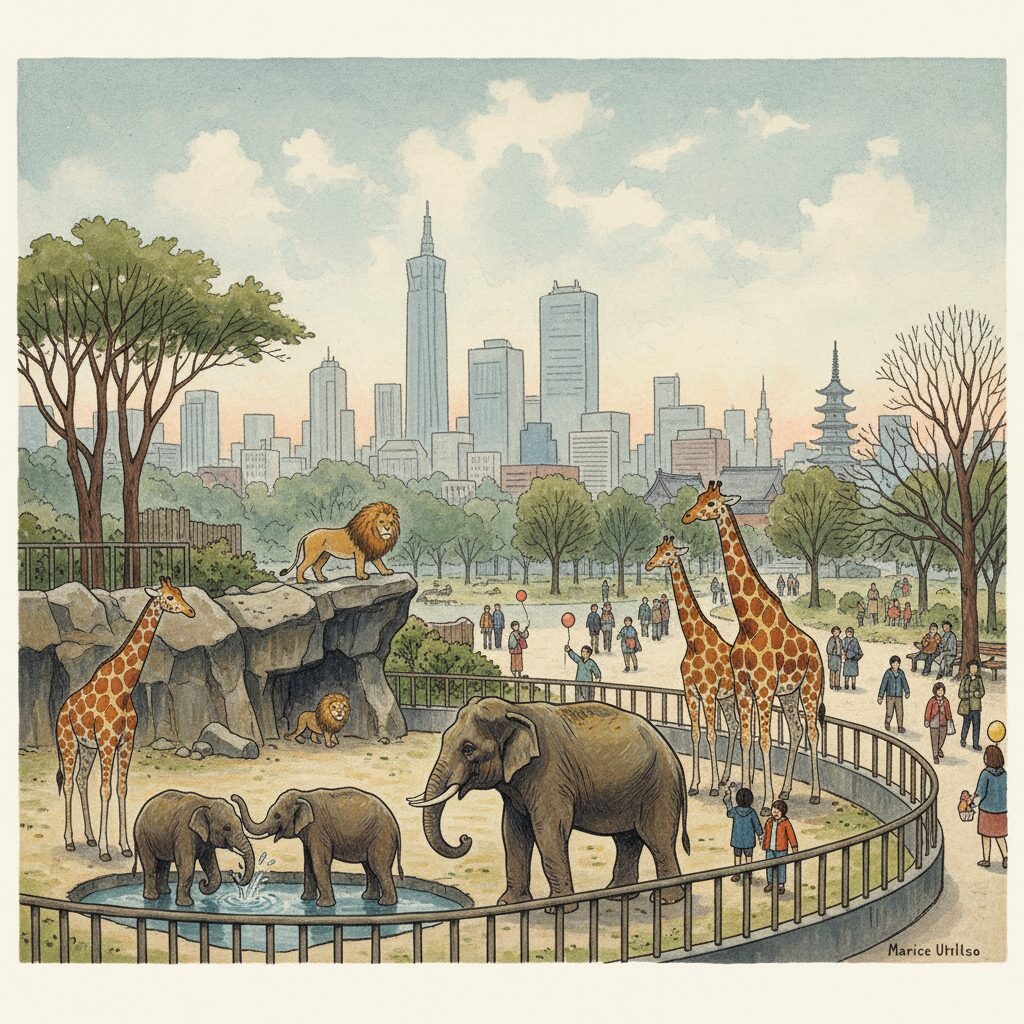
Nestled within the larger Tennoji Park lies another historic landmark of the area, Tennoji Zoo. Established in 1915, it is Japan’s third oldest zoo and holds a special nostalgic value for generations of Osakans. While maintaining a certain old-world charm, the zoo has recently made significant strides in modernizing its enclosures, creating more naturalistic habitats for its animals. A visit here offers a delightful and often surprising journey through the animal kingdom, right in the heart of the city.
One of the most striking sections is the African Savanna Zone. Using clever landscaping and moats, the zoo has crafted an environment where animals like giraffes, zebras, lions, and rhinos seem to roam together against a backdrop that fascinatingly, albeit jarringly, includes the Abeno Harukas skyscraper. This contrast between the wild and the urban provides a truly unique and memorable photo opportunity. Other highlights include the popular polar bear enclosure, where visitors can watch these magnificent creatures swim and play, and the nocturnal animal house, which reveals the hidden world of nighttime creatures. The Reptile House, known as IFAR (Institute for Amphibian and Reptile Research), is a cutting-edge facility showcasing a diverse collection of species from around the world. The zoo is compact enough to explore in just a few hours, making it an excellent activity for families or anyone seeking a break from the city. It offers a fun, educational, and affordable way to spend an afternoon.
Touching the Sky: Abeno Harukas
Rising like a colossal crystal from the heart of Tennoji, Abeno Harukas carries a name that means “to brighten, to clear up” in ancient Japanese. This name perfectly suits the tallest building in Japan. Standing at an impressive 300 meters, this skyscraper is the undeniable modern icon of Tennoji and a symbol of Osaka’s progressive and ambitious spirit. It functions as a vertical city in itself, housing a world-class department store, an art museum, a luxury hotel, and, at its peak, Japan’s most spectacular observation deck. As soon as you enter its realm, you are immersed in an atmosphere of sleek, contemporary design and refined energy—a perfect modern contrast to the ancient history of Shitennoji Temple just a short distance away.
The Ultimate View: Harukas 300 Observatory
The crowning feature of Abeno Harukas is the Harukas 300 observatory, situated on the building’s top three floors (58th to 60th). The journey begins with a smooth, silent elevator ride that takes you to the summit in under a minute, accompanied by a light show that heightens anticipation. Stepping onto the 60th floor and into the “Tenjo Kairo” or “Sky Corridor” is a stunning experience. Surrounded by floor-to-ceiling glass panels, you are treated to an uninterrupted 360-degree panorama of one of the world’s largest metropolitan areas. The vastness of the view is awe-inspiring. By day, you can trace the city’s layout—the cluster of skyscrapers in Umeda to the north, the ancient burial mounds of Sakai to the south, the protective Ikoma mountains to the east, and the shimmering waters of Osaka Bay stretching toward the port of Kobe to the west. On an exceptionally clear day, your view can even extend to Awaji Island and the mountains of Shikoku. This experience is both exhilarating and reflective, offering a god-like vantage point over the city’s intricate workings below.
As the sun sets, the observatory undergoes a transformation. The city lights begin to sparkle, spreading out like an endless carpet of shimmering gold, white, and red that reaches the horizon. This nighttime spectacle, often regarded as one of Japan’s finest views, is truly enchanting. For the adventurous, sections of glass flooring allow a thrilling look straight down 300 meters to the street below. The 58th floor features an open-air plaza called the “Sky Garden,” where you can enjoy the breeze while savoring a snack or drink from the Sky Garden 300 cafe. This multi-level experience makes Harukas 300 much more than a mere viewpoint—it’s a destination.
A World of Shopping and Culture Below
Abeno Harukas offers much more than its observatory. Most of the building is occupied by the Abeno Harukas Kintetsu Main Store, one of Japan’s largest and most impressive department stores. Spanning 14 floors, it’s a shopper’s paradise, offering everything from luxury international brands to exquisite Japanese crafts. The true highlight for many visitors, however, lies in the basement food halls, known as depachika. This dazzling culinary wonderland features perfectly crafted bento boxes, exquisite sushi, delicate French pastries, traditional Japanese sweets (wagashi), and a seemingly endless variety of gourmet foods to sample and purchase. It’s the ideal spot to gather a picnic for Tenshiba Park or find unique and delicious souvenirs.
On the 16th floor, the Abeno Harukas Art Museum awaits. This beautifully designed gallery hosts a rotating series of high-quality special exhibitions featuring both Japanese and Western art, as it does not have a permanent collection. It’s always worth checking their schedule to see what captivating exhibition is on during your visit. The 16th floor also boasts a lovely, free-to-access rooftop garden, offering pleasant city views even without a ticket to the main observatory.
A Labyrinth of Old Osaka: Shinsekai and the Tsutenkaku Tower
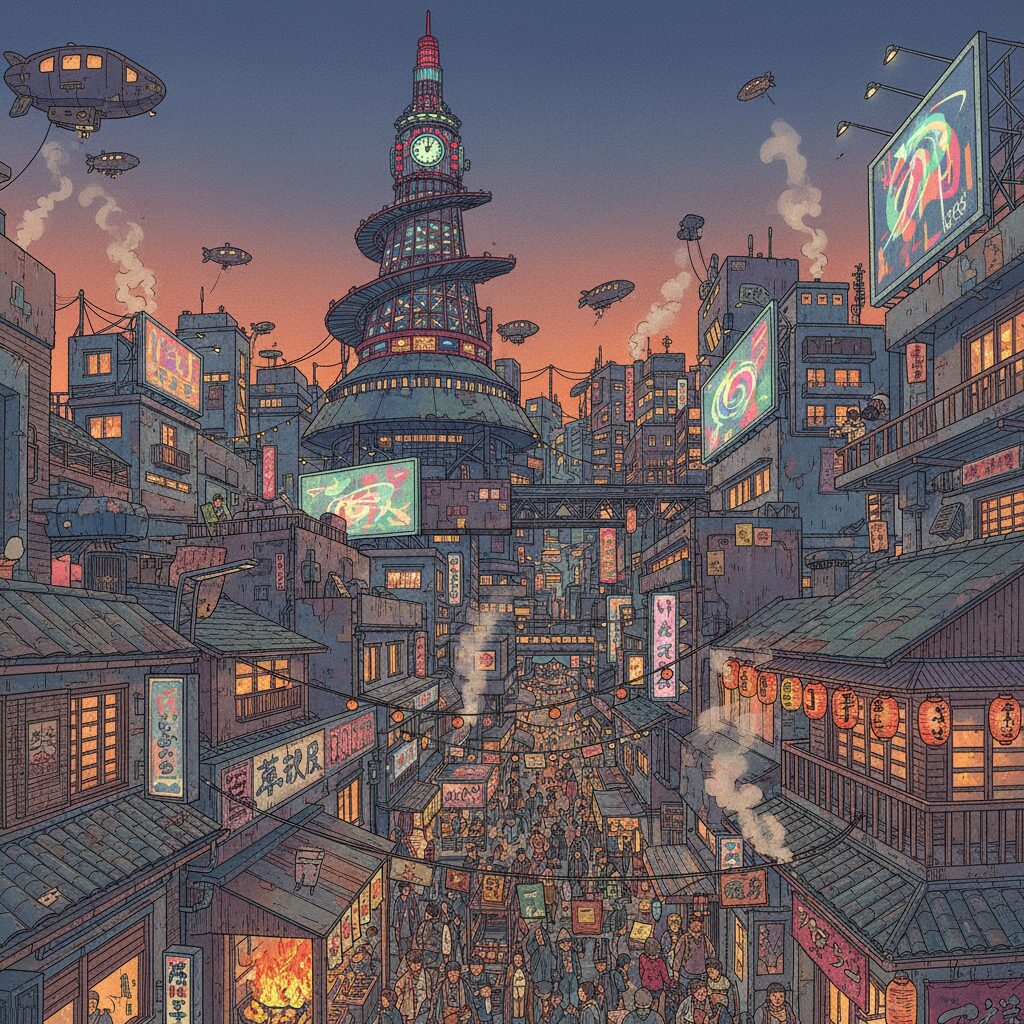
Just a short, captivating walk west from the sleek modernity of Tennoji Station lies a neighborhood that seems frozen in time from a bygone era. This is Shinsekai, which means “New World.” The name is ironic, as today the area serves as a gateway to the past, specifically the lively, hopeful, and somewhat rough-around-the-edges Japan of the Showa period (1926-1989). Originally developed before the war, its northern half was modeled after Paris while the southern half drew inspiration from New York’s Coney Island. Though the neighborhood’s fortunes have fluctuated over the years, Shinsekai has preserved its distinct, kitschy, and unmistakably charismatic spirit. The atmosphere bursts with sensation: flashy, oversized restaurant signs vie for your attention, the air is thick with the savory aroma of fried food, and the sounds of pachinko parlors and cheerful barkers fill the streets. It’s loud, colorful, and unapologetically authentic Osaka.
The Tower That Watches Over Naniwa: Tsutenkaku
At Shinsekai’s core stands its cherished and somewhat quirky landmark, Tsutenkaku Tower. Its name translates to “Tower Reaching Heaven,” and though it is now overshadowed by Abeno Harukas, it remains the neighborhood’s spiritual emblem and a nostalgic symbol for the entire city. The original tower, constructed in 1912 and inspired by the Eiffel Tower, was a marvel of its era. After being dismantled during World War II, enthusiastic citizens rebuilt it in 1956. Riding the elevator to the observation deck feels like stepping back in time, surrounded by retro designs and exhibits. From the top, you get a stunning view of Shinsekai’s vibrant streets and the surrounding Tennoji area. At the summit, you’ll find a shrine devoted to Billiken, a cherubic, smiling figure who was originally an American charm doll brought to Japan in the early 20th century. Known as “The God of Things As They Ought to Be,” it is said that rubbing the soles of his feet brings good luck. Joining locals to give his feet a friendly rub is a quintessential Shinsekai experience.
The Taste of the Neighborhood: Kushikatsu
Shinsekai is a culinary hotspot, and its undisputed specialty is kushikatsu. This is Osaka soul food at its best: various meats, seafood, and vegetables are skewered on bamboo sticks, coated in light panko breadcrumbs, and deep-fried to golden perfection. Dozens of kushikatsu eateries line the streets, from well-known chains like Ganso Kushikatsu Daruma to small, family-run spots. Eating kushikatsu comes with one inviolable rule: NO DOUBLE DIPPING. You’re given a communal pot of thin, savory dipping sauce shared among diners. Dip your skewer once—only once—at the start. If you want more sauce, use the provided cabbage leaf to scoop some onto your plate. Breaking this rule is a major culinary faux pas. Sitting at the counter, ordering skewers one by one, and savoring them with a cold beer is the perfect way to soak in Shinsekai’s lively, down-to-earth vibe.
Janjan Yokocho Alley
Along the edge of Shinsekai runs Janjan Yokocho, a narrow, covered shopping arcade that pulses as the neighborhood’s vibrant heart. The name is onomatopoeic, believed to come from the sound of shamisen instruments once played to draw in customers. Today, it’s a bustling, narrow lane filled with tiny standing bars, cheap and cheerful eateries, and serious old men hunched over boards in smoke-filled shogi (Japanese chess) and go clubs. Wandering through Janjan Yokocho offers an immersive glimpse into a side of local life that has remained unchanged for decades.
Navigating Tennoji: Access and Practical Advice
One of Tennoji’s greatest strengths is its accessibility. Tennoji Station serves as a major transportation hub, making it extremely easy to get to and an ideal starting point for exploring the broader region. It is a key station on the JR Osaka Loop Line, which encircles the city center, and is also served by the JR Yamatoji Line (offering direct access to Nara) and the Hanwa Line (linking to Wakayama and Kansai International Airport). Moreover, two of Osaka’s busiest subway lines, the Midosuji Line and the Tanimachi Line, pass through the station, providing seamless connections to major centers like Umeda, Namba, and Shinsaibashi. This convergence of train lines ensures that, no matter where you are in Osaka, Tennoji is just a short ride away.
Upon arrival, the area is remarkably walkable. Key attractions such as Shitennoji Temple, Tennoji Park, Tennoji Zoo, and the Abeno Harukas complex all lie within a five to fifteen-minute walk from the station. Shinsekai is also a pleasant ten-minute walk to the west. This compact arrangement makes it easy to experience the district’s incredible variety in a single, fulfilling day.
A Suggested One-Day Itinerary
To maximize your time, consider a plan that flows with the area’s vibrant energy. Begin your day with a serene morning visit to Shitennoji Temple, taking in its history and calm before the crowds arrive. Then, enjoy a relaxed stroll through Tennoji Park, perhaps pausing to unwind on the Tenshiba lawn. For lunch, you have plenty of choices: opt for a picnic in the park, visit one of the cafes at Tenshiba, or explore the culinary delights of the Abeno Harukas Kintetsu department store’s basement food hall. Spend your afternoon browsing the shops in Harukas or visiting the art museum. As the late afternoon approaches, head up to the Harukas 300 observatory to witness the stunning transition from day to night, as the sun sets and city lights begin to shimmer. For dinner, soak up the retro vibe of Shinsekai. Explore its lively streets, admire the glowing Tsutenkaku Tower, and end your day with a fun, delicious meal of kushikatsu and a cold drink, Osakan style.
Tips for First-Time Visitors
To ensure a smooth visit, keep a few things in mind. Wear comfortable walking shoes, as you will be exploring on foot extensively. When visiting Shitennoji Temple, show respect for worshippers and observe usual temple etiquette, such as cleansing your hands at the water basin before entering and speaking quietly. Remember the golden rule of kushikatsu: no double-dipping! Finally, for convenient travel on the city’s public transport, consider purchasing a rechargeable IC card like ICOCA available at any major train station.
Tennoji is a neighborhood of striking and fascinating contrasts. It is where fourteen centuries of faith stand beneath Japan’s tallest skyscraper, where the serenity of a sacred garden meets the lively energy of a retro entertainment district. It tells the story of Osaka—a city that values its deep roots while continually striving toward the future. A day spent exploring Tennoji’s many layers is more than a sightseeing trip; it is a profound and unforgettable journey into the very heart and soul of this dynamic city.
